93 Aquatic Biomes
Mary Ann Clark; Jung Choi; and Matthew Douglas
Learning Objectives
By the end of this section, you will be able to do the following:
- Describe the effects of abiotic factors on the composition of plant and animal communities in aquatic biomes
- Compare and contrast the characteristics of the ocean zones
- Summarize the characteristics of standing water and flowing water freshwater biomes
Abiotic Factors Influencing Aquatic Biomes
Like terrestrial biomes, aquatic biomes are influenced by a series of abiotic factors. The aquatic medium—water—has different physical and chemical properties than air, however. Even if the water in a pond or other body of water is perfectly clear (there are no suspended particles), water, on its own, absorbs light. As one descends into a deep body of water, there will eventually be a depth which the sunlight cannot reach. While there are some abiotic and biotic factors in a terrestrial ecosystem that might obscure light (like fog, dust, or insect swarms), usually these are not permanent features of the environment. The importance of light in aquatic biomes is central to the communities of organisms found in both freshwater and marine ecosystems. In freshwater systems, stratification due to differences in density is perhaps the most critical abiotic factor and is related to the energy aspects of light. The thermal properties of water (rates of heating and cooling and the ability to store much larger amounts of energy than the air) are significant to the function of marine systems and have major impacts on global climate and weather patterns. Marine systems are also influenced by large-scale physical water movements, such as currents; these are less important in most freshwater lakes.
The ocean is categorized by several areas or zones. All of the ocean’s open water is referred to as the pelagic realm (or zone). The benthic realm (or zone) extends along the ocean bottom from the shoreline to the deepest parts of the ocean floor. Within the pelagic realm is the photic zone, which is the portion of the ocean that light can penetrate (approximately 200 m or 650 ft). At depths greater than 200 m, light cannot penetrate; thus, this is referred to as the aphotic zone. The majority of the ocean is aphotic and lacks sufficient light for photosynthesis. The deepest part of the ocean, the Challenger Deep (in the Mariana Trench, located in the western Pacific Ocean), is about 11,000 m (about 6.8 mi) deep. To give some perspective on the depth of this trench, the ocean is, on average, 4267 m or 14,000 ft deep. These realms and zones are relevant to freshwater lakes as well.
Visual Connection
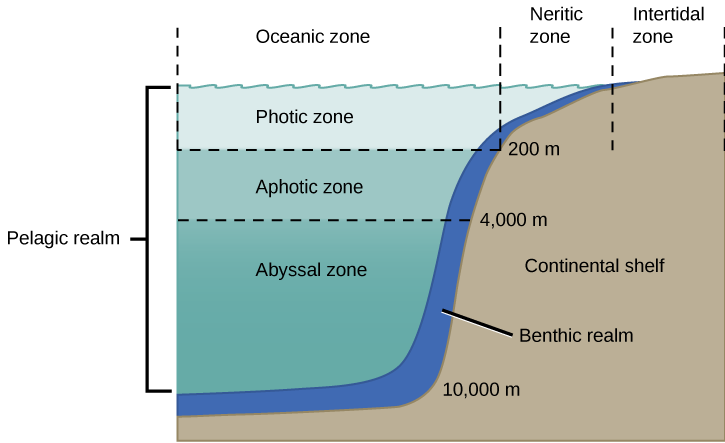
Marine Biomes
The ocean is the largest marine biome. It is a continuous body of salt water that is relatively uniform in chemical composition; in fact, it is a weak solution of mineral salts and decayed biological matter. Within the ocean, coral reefs are a second kind of marine biome. Estuaries, coastal areas where salt water and fresh water mix, form a third unique marine biome.
Ocean
The physical diversity of the ocean is a significant influence on plants, animals, and other organisms. The ocean is categorized into different zones based on how far light reaches into the water. Each zone has a distinct group of species adapted to the biotic and abiotic conditions particular to that zone.
The intertidal zone, which is the zone between high and low tide, is the oceanic region that is closest to land. Generally, most people think of this portion of the ocean as a sandy beach. In some cases, the intertidal zone is indeed a sandy beach, but it can also be rocky or muddy. The intertidal zone is an extremely variable environment because of action of tidal ebb and flow. Organisms are exposed to air and sunlight at low tide and are underwater most of the time, especially during high tide. Therefore, living things that thrive in the intertidal zone are adapted to being dry for long periods of time (see the figure below). The shore of the intertidal zone may also be repeatedly struck by waves, and the organisms found there are adapted to withstand damage from their pounding action. The exoskeletons of shoreline crustaceans (such as the shore crab, Carcinus maenas) are tough and protect them from desiccation (drying out) and wave damage. Another consequence of the pounding waves is that few algae and plants establish themselves in the constantly moving rocks, sand, or mud.
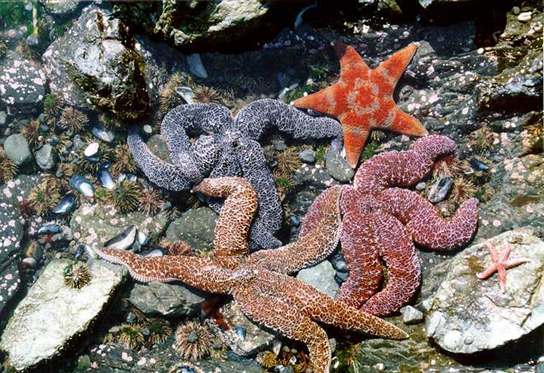
The neritic zone extends from the intertidal zone to depths of about 200 m (or 650 ft) at the edge of the continental shelf (the underwater landmass that extends from a continent). Since light can penetrate this depth, photosynthesis can still occur in the neritic zone. The water here contains silt and is well-oxygenated, low in pressure, and stable in temperature. Phytoplankton and floating Sargassum (a type of free-floating marine seaweed) provide a habitat for some sea life found in the neritic zone. Zooplankton, protists, small fishes, and shrimp are found in the neritic zone and are the base of the food chain for most of the world’s fisheries.
Beyond the neritic zone is the open ocean area known as the pelagic or open oceanic zone. Within the oceanic zone there is thermal stratification where warm and cold waters mix because of ocean currents. Abundant plankton serve as the base of the food chain for larger animals such as whales and dolphins. Nutrients are scarce and this is a relatively less productive part of the marine biome. When photosynthetic organisms and the protists and animals that feed on them die, their bodies fall to the bottom of the ocean, where they remain. Unlike freshwater lakes, most of the open ocean lacks a process for bringing the organic nutrients back up to the surface. (Exceptions include major oceanic upwellings within the Humboldt Current along the western coast of South America.) The majority of organisms in the aphotic zone include sea cucumbers (phylum Echinodermata) and other organisms that survive on the nutrients contained in the dead bodies of organisms in the photic zone.
Beneath the pelagic zone is the benthic realm, the deep-water region beyond the continental shelf. The bottom of the benthic realm is composed of sand, silt, and dead organisms. Temperature decreases, remaining above freezing, as water depth increases. This is a nutrient-rich portion of the ocean because of the dead organisms that fall from the upper layers of the ocean. Because of this high level of nutrients, a diversity of fungi, sponges, sea anemones, marine worms, sea stars, fishes, and bacteria exist.
The deepest part of the ocean is the abyssal zone, which is at depths of 4000 m or greater. The abyssal zone is very cold and has very high pressure, high oxygen content, and low nutrient content. There are a variety of invertebrates and fishes found in this zone, but the abyssal zone does not have plants because of the lack of light. Hydrothermal vents are found primarily in the abyssal zone; chemosynthetic bacteria utilize the hydrogen sulfide and other minerals emitted from the vents. These chemosynthetic bacteria use the hydrogen sulfide as an energy source and serve as the base of the food chain found in the abyssal zone.
Coral Reefs
Coral reefs (see the figure below) are ocean ridges formed by marine invertebrates, comprising mostly cnidarians and mollusks, living in warm shallow waters within the photic zone of the ocean. They are found within 30˚ north and south of the equator. The Great Barrier Reef is perhaps the best-known and largest reef system in the world—visible from the International Space Station! This massive and ancient reef is located several miles off the northeastern coast of Australia. Other coral reef systems are fringing islands, which are directly adjacent to land, or atolls, which are circular reef systems surrounding a former landmass that is now underwater. The coral organisms (members of phylum Cnidaria) are colonies of saltwater polyps that secrete a calcium carbonate skeleton. These calcium-rich skeletons slowly accumulate, forming the underwater reef. Corals found in shallower waters (at a depth of approximately 60 m or about 200 ft) have a mutualistic relationship with photosynthetic unicellular algae. The relationship provides corals with the majority of the nutrition and the energy they require. The waters in which these corals live are nutritionally poor and, without this mutualism, it would not be possible for large corals to grow. Some corals living in deeper and colder water do not have a mutualistic relationship with algae; these corals attain energy and nutrients using stinging cells called cnidocytes on their tentacles to capture prey.
Link to Learning
Watch this National Oceanic and Atmospheric Administration (NOAA) video to see marine ecologist Dr. Peter Etnoyer discuss his research on coral organisms.
It is estimated that more than 4,000 fish species inhabit coral reefs. These fishes can feed on coral, the cryptofauna (invertebrates found within the calcium carbonate substrate of the coral reefs), or the seaweed and algae that are associated with the coral. In addition, some fish species inhabit the boundaries of a coral reef; these species include predators, herbivores, and planktivores, which consume planktonic organisms such as bacteria, archaea, algae, and protists floating in the pelagic zone.
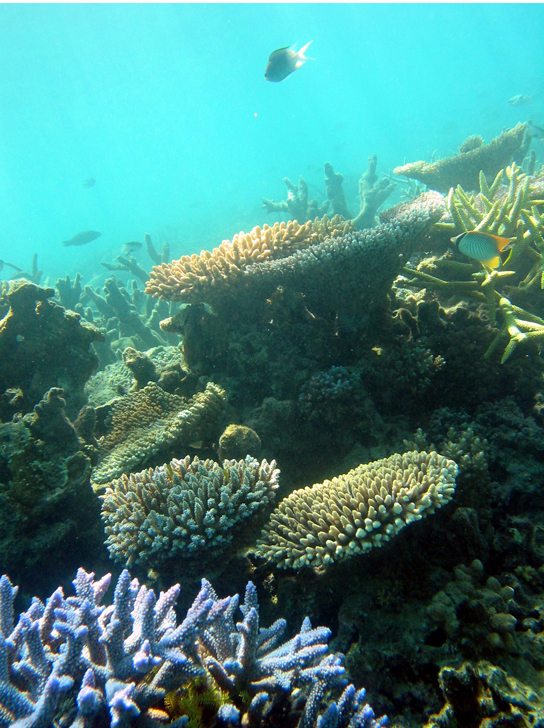
Evolution Connection
Global Decline of Coral Reefs
It takes many thousands of years to build a coral reef. The animals that create coral reefs have evolved over millions of years, continuing to slowly deposit the calcium carbonate that forms their characteristic ocean homes. Bathed in warm tropical waters, the coral animals and their symbiotic algal partners evolved to survive at the upper limit of ocean water temperature.
Together, climate change and human activity pose dual threats to the long-term survival of the world’s coral reefs. As global warming due to fossil fuel emissions raises ocean temperatures, coral reefs are suffering. The excessive warmth causes the reefs to lose their symbiotic, food-producing algae, resulting in a phenomenon known as bleaching. When bleaching occurs, the reefs lose much of their characteristic color as the algae, and the coral animals die if loss of the symbiotic zooxanthellae is prolonged.
Rising levels of atmospheric carbon dioxide further threaten the corals in other ways; as CO2 dissolves in ocean waters, it lowers the pH and increases ocean acidity. As acidity increases, it interferes with the calcification that normally occurs when coral animals build their calcium carbonate shelters.
When a coral reef begins to die, species diversity plummets as animals lose food and shelter. Coral reefs are also economically important tourist destinations, so the decline of coral reefs poses a serious threat to coastal economies.
Human population growth has damaged corals in other ways, too. As human coastal populations increase, the runoff of sediment and agricultural chemicals has increased, as well, causing some of the once-clear tropical waters to become cloudy. At the same time, overfishing of popular fish species has allowed the predator species that eat corals to go unchecked.
Although a rise in global temperatures of 1–2 ˚C (a conservative scientific projection) in the coming decades may not seem large, it is very significant to this biome. When change occurs rapidly, species can become extinct before evolution can offer new adaptations. Many scientists believe that global warming, with its rapid (in terms of evolutionary time) and inexorable increases in temperature, is tipping the balance beyond the point from which many of the world’s coral reefs can recover.
Estuaries: Where the Ocean Meets Fresh Water
Estuaries are biomes that occur where a source of fresh water, such as a river, meets the ocean. Therefore, both fresh water and salt water are found in the same vicinity; mixing results in a diluted (brackish) saltwater. Estuaries form protected areas where many of the young offspring of crustaceans, mollusks, and fish begin their lives, which also creates important breeding grounds for other animals. Salinity is a very important factor that influences the organisms and the adaptations of the organisms found in estuaries. The salinity of estuaries varies considerably and is based on the rate of flow of its freshwater sources, which may depend on the seasonal rainfall. Once or twice a day, high tides bring salt water into the estuary. Low tides occurring at the same frequency reverse the current of salt water.
The short-term and rapid variation in salinity due to the mixing of fresh water and salt water is a difficult physiological challenge for the plants and animals that inhabit estuaries. Many estuarine plant species are halophytes: plants that can tolerate salty conditions. Halophytic plants are adapted to deal with the salinity resulting from saltwater on their roots or from sea spray. In some halophytes, filters in the roots remove the salt from the water that the plant absorbs. Other plants are able to pump oxygen into their roots. Animals, such as mussels and clams (phylum Mollusca), have developed behavioral adaptations that expend a lot of energy to function in this rapidly changing environment. When these animals are exposed to low salinity, they stop feeding, close their shells, and switch from aerobic respiration (in which they use gills to remove oxygen from the water) to anaerobic respiration (a process that does not require oxygen and takes place in the cytoplasm of the animal’s cells). When high tide returns to the estuary, the salinity and oxygen content of the water increases, and these animals open their shells, begin feeding, and return to aerobic respiration.
Freshwater Biomes
Freshwater biomes include lakes and ponds (standing water) as well as rivers and streams (flowing water). They also include wetlands, which will be discussed later. Humans rely on freshwater biomes to provide ecosystem benefits, which are aquatic resources for drinking water, crop irrigation, sanitation, and industry. Lakes and ponds are connected with abiotic and biotic factors influencing their terrestrial biomes.
Lakes and Ponds
Lakes and ponds can range in area from a few square meters to thousands of square kilometers. Temperature is an important abiotic factor affecting living things found in lakes and ponds. In the summer, as we have seen, thermal stratification of lakes and ponds occurs when the upper layer of water is warmed by the sun and does not mix with deeper, cooler water. Light can penetrate within the photic zone of the lake or pond. Phytoplankton (algae and cyanobacteria) are found here and carry out photosynthesis, providing the base of the food web of lakes and ponds. Zooplankton, such as rotifers and larvae and adult crustaceans, consume these phytoplankton. At the bottom of lakes and ponds, bacteria in the aphotic zone break down dead organisms that sink to the bottom.
Nitrogen and phosphorus are important limiting nutrients in lakes and ponds. Because of this, they are the determining factors in the amount of phytoplankton growth that takes place in lakes and ponds. When there is a large input of nitrogen and phosphorus (from sewage and runoff from fertilized lawns and farms, for example), the growth of algae skyrockets (see the figure below), resulting in a large accumulation of algae called an algal bloom. Algal blooms can become so extensive that they reduce light penetration in water. They may also release toxic byproducts into the water, contaminating any drinking water taken from that source. In addition, the lake or pond becomes aphotic, and photosynthetic plants cannot survive. When the algae die and decompose, severe oxygen depletion of the water occurs. Fishes and other organisms that require oxygen are then more likely to die, resulting in a dead zone. Lake Erie and the Gulf of Mexico represent freshwater and marine habitats where phosphorus control and storm water runoff pose significant environmental challenges.
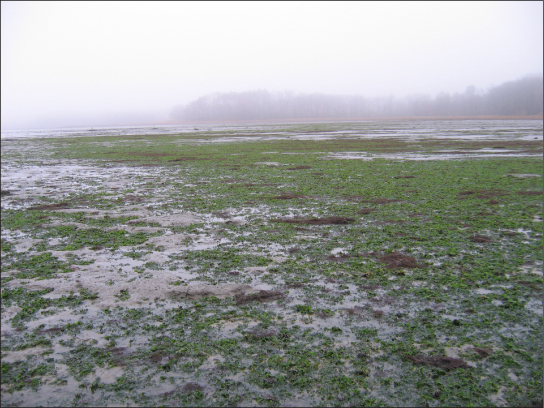
Rivers and Streams
Rivers and streams are continuously moving bodies of water that carry large amounts of water from the source, or headwater, to a lake or ocean. The largest rivers include the Nile River in Africa, the Amazon River in South America, and the Mississippi River in North America.
Abiotic features of rivers and streams vary along the length of the river or stream. Streams begin at a point of origin referred to as source water. The source water is usually cold, low in nutrients, and clear. The channel (the width of the river or stream) is narrower than at any other place along the length of the river or stream. Because of this, the current is often faster here than at any other point of the river or stream.
The fast-moving water results in minimal silt accumulation at the bottom of the river or stream; therefore, the water is usually clear and free of debris. Photosynthesis here is mostly attributed to algae that are growing on rocks; the swift current inhibits the growth of phytoplankton. An additional input of energy can come from leaves and other organic material that fall downstream into the river or stream, as well as from trees and other plants that border the water. When the leaves decompose, the organic material and nutrients in the leaves are returned to the water. Plants and animals have adapted to this fast-moving water. For instance, leeches (phylum Annelida) have elongated bodies and suckers on the anterior and ventral areas of the body. These suckers attach to the substrate, keeping the leech anchored in place, and are also used to attach to their prey. Freshwater trout species (phylum Chordata) are an important predator in these fast-moving rivers and streams.
As the river or stream flows away from the source, the width of the channel gradually widens and the current slows. This slow-moving water, caused by the gradient decrease and the volume increase as tributaries unite, has more sedimentation. Phytoplankton can also be suspended in slow-moving water. Therefore, the water will not be as clear as it is near the source. The water is also warmer. Worms (phylum Annelida) and insects (phylum Arthropoda) can be found burrowing into the mud. The higher order predator vertebrates (phylum Chordata) include waterfowl, frogs, and fishes. These predators must find food in the slow moving, sometimes murky waters and, unlike the trout in the waters at the source, these vertebrates may not be able to use vision as their primary sense to find food. Instead, they are more likely to use taste or chemical cues to find prey.
Wetlands
Wetlands are environments in which the soil is either permanently or periodically saturated with water. Wetlands are different from lakes because wetlands are shallow bodies of water whereas lakes vary in depth. Emergent vegetation consists of wetland plants that are rooted in the soil but have portions of leaves, stems, and flowers extending above the water’s surface (see the figure below). There are several types of wetlands including marshes, swamps, bogs, mudflats, and salt marshes. The three shared characteristics among these types—what makes them wetlands—are their hydrology, hydrophytic vegetation, and hydric soils.
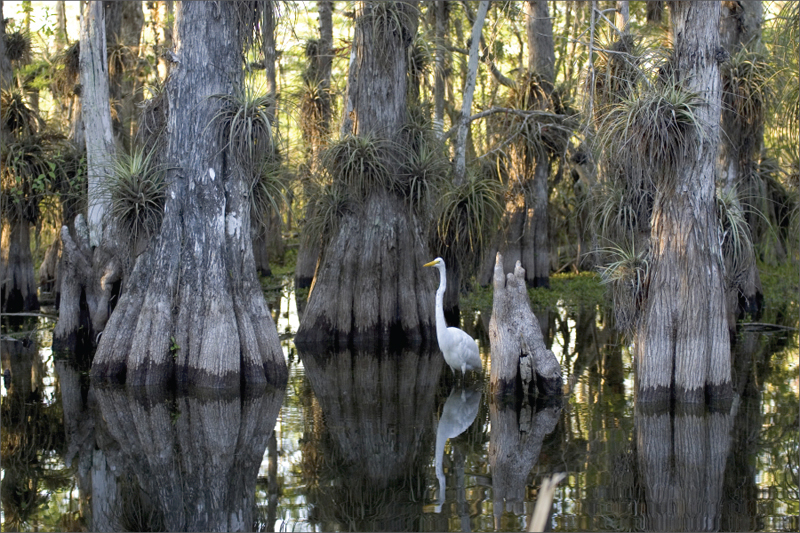
Freshwater marshes and swamps are characterized by slow and steady water flow. Bogs, however, develop in depressions where water flow is low or nonexistent. Bogs usually occur in areas where there is a clay bottom with poor percolation of water. (Percolation is the movement of water through the pores in the soil or rocks.) The water found in a bog is stagnant and oxygen-depleted because the oxygen used during the decomposition of organic matter is not readily replaced. As the oxygen in the water is depleted, decomposition slows. This leads to a buildup of acids and a lower water pH. The lower pH creates challenges for plants because it limits the available nitrogen. As a result, some bog plants (such as sundews, pitcher plants, and Venus flytraps) capture insects in order to extract the nitrogen from their bodies. Bogs have low net primary productivity because the water found in bogs has low levels of nitrogen and oxygen.
Section Summary
Aquatic ecosystems include both saltwater and freshwater biomes. The abiotic factors important for the structuring of aquatic ecosystems can be different than those seen in terrestrial systems. Sunlight is a driving force behind the structure of forests and also is an important factor in bodies of water, especially those that are very deep, because of the role of photosynthesis in sustaining certain organisms.
Density and temperature shape the structure of aquatic systems. Oceans may be thought of as consisting of different zones based on water depth and distance from the shoreline and light penetrance. Different kinds of organisms are adapted to the conditions found in each zone. Coral reefs are unique marine ecosystems that are home to a wide variety of species. Estuaries are found where rivers meet the ocean; their shallow waters provide nourishment and shelter for young crustaceans, mollusks, fishes, and many other species. Freshwater biomes include lakes, ponds, rivers, streams, and wetlands. Bogs are an interesting type of wetland characterized by standing water, lower pH, and a lack of nitrogen.

